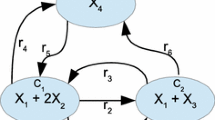Abstract
A numerical procedure for finding the sparsest and densest realization of a given reaction network is proposed in this paper. The problem is formulated and solved in the framework of mixed integer linear programming (MILP) where the continuous optimization variables are the nonnegative reaction rate coefficients, and the corresponding integer variables ensure the finding of the realization with the minimal or maximal number of reactions. The mass-action kinetics is expressed in the form of linear constraints adjoining the optimization problem. More complex realization problems can also be solved using the proposed framework by modifying the objective function and/or the constraints appropriately.
Similar content being viewed by others
References
Aykanat C., Pinar A.: Permuting sparse rectangular matrices into block-diagonal form. SIAM J. Scientific Comput. 25, 1860–1879 (2004)
J. Bang-Jensen, G. Gutin, Digraphs: Theory, Algorithms and Applications (Springer, 2001)
Bemporad A., Morari M.: Control of systems integrating logic, dynamics, and constraints. Automatica 35, 407–427 (1999)
Cavalier T.M., Pardalos P.M., Soyster A.L.: Modeling and integer programming techniques applied to propositional calculus. Comput. Oper. Res. 17(6), 561–570 (1990)
Craciun G., Feinberg M.: Multiple equilibria in complex chemical reaction networks: I. The injectivity property. SIAM J. Appl. Math. 65(5), 1526–1546 (2005)
Craciun G., Feinberg M.: Multiple equilibria in complex chemical reaction networks: II. The species-reaction graph. SIAM J. Appl. Math. 66(4), 1321–1338 (2006)
Craciun G., Pantea C.: Identifiability of chemical reaction networks. J. Math. Chem. 44, 244–259 (2008)
Craciun G., Tang Y., Feinberg M.: Understanding bistability in complex enzyme-driven reaction networks. Proc. Natl. Acad. Sci. USA 103(23), 8697–8702 (2006)
Donoho D.L.: For most large undetermined systems of linear equations the minimal l1-norm solution is also the sparsest solution. Commun. Pure Appl. Math. 59(7), 903–934 (2006)
Donoho D.L., Tanner J.: Sparse nonnegative solution of underdetermined linear equations by linear programming. Proc. Natl. Acad. Sci. USA 102(27), 9446–9451 (2005)
P. Érdi, J. Tóth, Mathematical Models of Chemical Reactions. Theory and Applications of Deterministic and Stochastic Models (Manchester University Press, Princeton University Press, Manchester, Princeton, 1989)
Farkas Gy.: Local controllability of reactions. J. Math. Chem. 24, 1–14 (1998)
Farkas Gy.: On local observability of chemical systems. J. Math. Chem. 24, 15–22 (1998)
Farkas Gy.: Kinetic lumping schemes. Chem. Eng. Sci. 54, 3909–3915 (1999)
M. Feinberg, Lectures on Chemical Reaction Networks. Notes of lectures given at the Mathematics Research Center (University of Wisconsin, 1979)
Feinberg M.: Chemical reaction network structure and the stability of complex isothermal reactors—I. The deficiency zero and deficiency one theorems. Chem. Eng. Sci. 42(10), 2229–2268 (1987)
Feinberg M.: Chemical reaction network structure and the stability of complex isothermal reactors—II. Multiple steady states for networks of deficiency one. Chem. Eng. Sci. 43, 1–25 (1988)
C.A. Floudas, Nonlinear and Mixed-Integer Optimization (Oxford University Press, 1995)
Gorban A.N., Karlin I.V.: Method of invariant manifold for chemical kinetics. Chem. Eng. Sci. 58, 4751–4768 (2003)
Gorban A.N., Karlin I.V., Zinovyev A.Y.: Invariant grids for reaction kinetics. Physica A 33, 106–154 (2004)
K.M. Hangos, G. Szederkényi, Special positive systems: the QP and the reaction kinetic system class, in Preprints of the Workshop on Systems and Control Theory in Honor of József Bokor on His 60th Birthday (Hungarian Academy of Sciences, 2008)
Hansen P., Zheng M.: The Clar number of a benzenoid hydrocarbon and linear programming. J. Math. Chem. 15, 93–107 (1992)
V. Hárs, J. Tóth. On the inverse problem of reaction kinetics, in Qualitative Theory of Differential Equations, vol 30 of Coll. Math. Soc. J. Bolyai, ed. by M. Farkas, L. Hatvani (North-Holland, Amsterdam, 1981), pp. 363–379
K. Homlström, M.M. Edvall, A.O. Göran, TOMLAB for large-scale robust optimization, in Nordic MATLAB Conference (2003)
J. Löfberg, YALMIP: a toolbox for modeling and optimization in MATLAB, in Proceedings of the CACSD Conference (Taipei, Taiwan, 2004)
A. Makhorin, GNU Linear Programming Kit. Reference Manual.Version 4.10 (2006)
G.L. Nemhauser, L.A. Wolsey. Integer and Combinatorial Optimization (Wiley, 1988)
Otero-Muras I., Szederkényi G., Alonso A.A., Hangos K.M.: Local dissipative Hamiltonian description of reversible reaction networks. Syst. Control Lett. 57, 554–560 (2008)
Raman R., Grossmann I.E.: Relation between MILP modelling and logical inference for chemical process synthesis. Comput. Chem. Eng. 15, 73–84 (1991)
Raman R., Grossmann I.E.: Integration of logic and heuristic knowledge in MINLP optimization for process synthesis. Comput. Chem. Eng. 16(3), 155–171 (1992)
Raman R., Grossmann I.E.: Modelling and computational techniques for logic based integer programming. Comput. Chem. Eng. 18, 563–578 (1994)
Saled K., Abeledo H.: Alternative integer-linear-programming formulations of the Clar problem in hexagonal systems. J. Math. Chem. 39, 605–610 (2006)
Schnell S., Chappell M.J., Evans N.D., Roussel M.R.: The mechanism distinguishability problem in biochemical kinetics: the single-enzyme, single-substrate reaction as a case study. C. R. Biol. 329, 51–61 (2006)
Sontag E.: Structure and stability of certain chemical networks and applications to the kinetic proofreading model of T-cell receptor signal transduction. IEEE Trans. Autom. Control. 46, 1028–1047 (2001)
Thomas R., Kaufman M.: Multistationarity, the basis of cell differentiation and memory. I. Structural conditions of multistationarity and other nontrivial behaviour. Chaos 11, 170–179 (2001)
H.P. Williams, Model Building in Mathematical Programming (Wiley, 1993)
Author information
Authors and Affiliations
Corresponding author
Rights and permissions
About this article
Cite this article
Szederkényi, G. Computing sparse and dense realizations of reaction kinetic systems. J Math Chem 47, 551–568 (2010). https://doi.org/10.1007/s10910-009-9525-5
Received:
Accepted:
Published:
Issue Date:
DOI: https://doi.org/10.1007/s10910-009-9525-5




